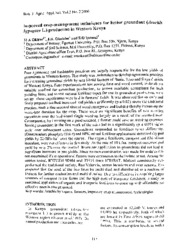| dc.description.abstract | Poor agronomic and husbandry practices are largely responsible for the low yields of
groundnuts in Western Kenya. This study was undertaken to develop agronomic practices
for increasing groundnut yields by small-hold farmers of Busia, Teso and Siaya districts
of Western Kenya. Four experiments-to test sowing time and weed control, to develop a
suitable seedbed for groundnut production, to screen available germplasm for high
yielding lines, and to test various fertilizer types for use in groundnut production, were
set up. These experiments were laid in farmers’ fields. It was observed that an early and
finely prepared seedbed increased pod yields significantly (p «; 0.05) above the traditional
practice. Such a fine seedbed slowed weed emergence and buildup thereby increasing the
weed-free duration for the crop. There were no significant benefits of two weeding
operations over the traditional single weeding largely as a result of the seedbed used.
Consequently, by investing on a good seedbed, a farmer could save on weeding expenses.
Sowing groundnut in the first week of the rains led to a significantly (p s 0.05) higher
yield over subsequent dates. Groundnuts responded to fertilizer types differently.
(Diammonium phosphate (DAP) and NPK mixed fertilizer applications increased dry pod
yields by 22-50% ha'1 over the control. The organic fertilizers, compost and Rhizobiuin
inoculant, were not effective in this study. At the rate of 10 t /ha, compost increased pod
yield by only 2% over the control. Inoculant application to groundnuts did not lead to
significant increases in pod yields. Since no root examination was made for nodules it is
not ascertained if the operational factors were extraneous to the isolate or not. Among the
entries tested, ICGVSM 90904 and 93535 from 1CRISAT. Malawi consistently Out
performed the traditional variety, Red Valencia, across locations and over seasons. It is
proposed that the seed of the two lines be multiplied and distributed to a nucleus of
farmers for further evaluation and multiplication. Due to difficulties in acquiring larger
volumes of compost in the farms and the high cost of inorganic fertilizers, a study on
combined application of organic and inorganic fertilizers to come up with affordable but
effective rates is also proposed. | en_US |

